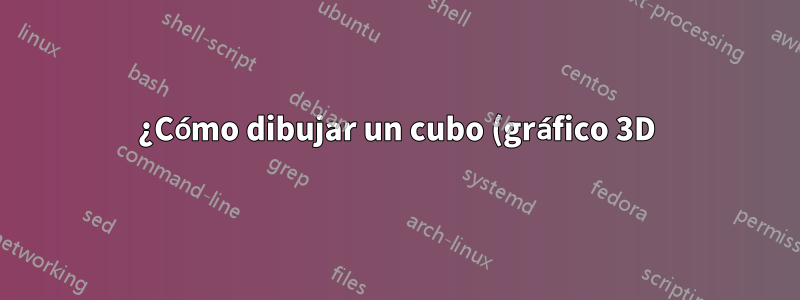%20con%20l%C3%ADneas%20discontinuas%20en%20lugar%20de%20l%C3%ADneas%20s%C3%B3lidas%20en%20TikZ%3F.png)
A continuación se muestra una figura de un cubo (o un gráfico 3D), junto con una imagen externa (y su código esaquí). Estoy intentando utilizar líneas discontinuas en lugar de líneas continuas en esta figura. He comprobado estos enlaces,enlace2,enlace3, yenlace4, pero necesito ayuda para resolver este problema.
\documentclass{standalone}
\usepackage{pgfplots}
\usetikzlibrary{3d,calc}
\begin{document}
\begin{tikzpicture}
\begin{axis}[
enlargelimits=false,
axis on top,
axis equal image,
xmin=0,xmax=4,
ymin=-1,ymax=1,
zmin=-1,zmax=1,
ylabel=$X$,zlabel=$Y$, %xlabel=$Z$,
view={-20}{30},
xtick={0, 4},
ticks = none,
clip = false,
]
\draw [black,dashed]
(axis cs:?) -- (axis cs:?) % ???
(axis cs:?) -- (axis cs:?);
\path (axis cs:0,0,0) coordinate (O) (axis cs:1,0,0) coordinate (X)
(axis cs:0,1,0) coordinate (Y) (axis cs:0,0,1) coordinate (Z)
(axis cs:4,0,0) coordinate (P)
[x={($(O)-(X)$)},y={($(O)-(Y)$)},z={($(Z)-(O)$)},
canvas is yz plane at x=0,transform shape]
(P) node{\includegraphics[width=2cm,height=2cm]{example-image-duck}};
\path (axis cs:0,0,0) coordinate (O) (axis cs:1,0,0) coordinate (X)
(axis cs:0,1,0) coordinate (Y) (axis cs:0,0,1) coordinate (Z)
(axis cs:0,0,0) coordinate (P)
[x={($(O)-(X)$)},y={($(O)-(Y)$)},z={($(Z)-(O)$)},
canvas is yz plane at x=0,transform shape]
(P) node{\includegraphics[width=2cm,height=2cm]{example-image-duck}};
%\draw[black, <->] ([xshift =-0.09cm] axis description cs:0, 0.2) -- node[left] {} ([xshift =-0.1cm] axis description cs:0, 0.66) node[font=\scriptsize, midway, left=-1mm] {\fontsize{6.5}{6.5}\selectfont$y$};
%\draw[black, <->] ([xshift =-.14cm] axis description cs:0.01, 0.19) -- node[left] {} ([xshift =-.39cm] axis description cs:0.35,- 0.01)node[font=\scriptsize, midway,below] {\fontsize{6.5}{6.5}\selectfont$x$};
\end{axis}
\end{tikzpicture}
\end{document}
Respuesta1
No tengo muy claro qué estás intentando hacer o cómo todo lo que has intentado no ha funcionado, pero tal vez algo como esto...
Sin embargo, hay cero cubos en esta respuesta.
\documentclass{standalone}
% ateb: https://tex.stackexchange.com/a/705675/ addaswyd o ateb user194703: https://tex.stackexchange.com/a/516994/
\usepackage{pgfplots}
\usetikzlibrary{3d,calc}
\begin{document}
\pgfplotsset{%
every axis/.append style={%
draw=lightgray
},
}%
\begin{tikzpicture}
\begin{axis}[
enlargelimits=false,
axis equal image,
xmin=0,xmax=4,
ymin=-1,ymax=1,
zmin=-1,zmax=1,
xlabel=$x$,ylabel=$y$,zlabel=$z$,
view={-20}{30},
xtick={0, 3},
]
\draw [red,dashed]
(axis cs:0,1,1) -- (axis cs:4,1,1)
(axis cs:0,1,-1) -- (axis cs:4,1,-1);
\path (axis cs:0,0,0) coordinate (O) (axis cs:1,0,0) coordinate (X)
(axis cs:0,1,0) coordinate (Y) (axis cs:0,0,1) coordinate (Z)
(axis cs:3,0,0) coordinate (P)
[x={($(X)-(O)$)},y={($(Y)-(O)$)},z={($(Z)-(O)$)},
canvas is yz plane at x=0,transform shape]
(P) node{\includegraphics[width=2cm,height=2cm]{example-image-duck}};
\draw [red,densely dashed]
(axis cs:0,-1,1) -- (axis cs:4,-1,1)
(axis cs:0,-1,-1) -- (axis cs:4,-1,-1);
\end{axis}
\end{tikzpicture}
\end{document}




